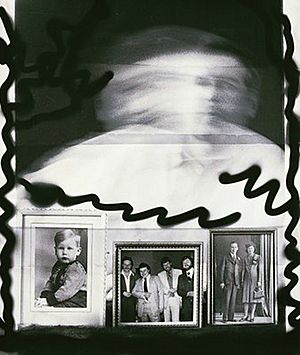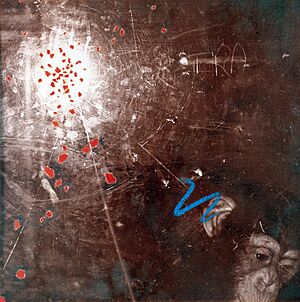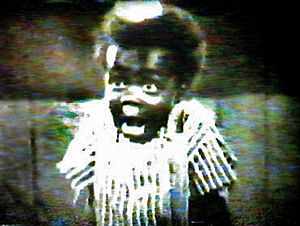Victor Sloan facts for kids
Quick facts for kids
Victor Sloan
|
|
|---|---|

"Self-Portrait", silver gelatin print, with coloured pencils, 60 cm x 50 cm, 1993
|
|
| Born | 16 July 1945 Dungannon, County Tyrone, Northern Ireland
|
| Nationality | British (Northern Irish) |
| Education | Belfast College of Art, Leeds College of Art and Design |
| Known for | Photography, Video, Mixed Media |
| Awards | MBE |
Victor Sloan is a famous photographer and artist from Northern Ireland. He was born in 1945 and is known for his unique way of creating art. He often uses photography to explore important ideas about society, politics, and religion.
Contents
About Victor Sloan and His Art
Early Life and Training
Victor Sloan was born in 1945 in Dungannon, a town in County Tyrone, Northern Ireland. He went to school at the Royal School, Dungannon. Later, he studied art at colleges in Belfast and Leeds, England. Today, he lives and works in Portadown, County Armagh, Northern Ireland.
How He Creates His Art
Victor Sloan mainly uses photography for his artwork. But he doesn't just take pictures! He often changes his photo negatives and prints. He adds paints, inks, and dyes to them. This makes his photographs look very special and unique. Besides photos, he also creates video art and uses printmaking techniques.
Exploring Important Topics
Sloan's art often explores big ideas about society, politics, and religion. He is especially known for his work about the Orange Order. This is a Protestant organization in Northern Ireland. Some of his famous series about this topic include Drumming, The Walk, the Platform and the Field, and The Birches.
Awards and Recognition
Victor Sloan has received many awards for his art. In 2002, he was given an MBE (Member of the Most Excellent Order of the British Empire). This is a special award from the British government. He is also a member of the Royal Ulster Academy and a Fellow of the Royal Society of Arts. He has won the Academy's Conor Prize and Gold Medal multiple times.
Major Art Shows
Many galleries have shown Victor Sloan's work. In 2001, the Ormeau Baths Gallery in Belfast had a big show called Victor Sloan: Selected Works 1980–2000. In 2008, the Golden Thread Gallery in Belfast featured his video art in an exhibition called History, Locality, Allegiance.
Another important exhibition was Victor Sloan: Drift. This show told the story of the Vietnamese boat people. These were people from Vietnam who settled in Craigavon, Northern Ireland, in 1979. For this show, Sloan reconnected with a man named Ka Fue Lay, who was a teenager when he arrived in Craigavon. Sloan made a video where Ka Fue Lay shared his life story. The exhibition also included Sloan's black and white photos of Craigavon from the 1970s and 1980s.
In 2017, Sloan's exhibition Before at Belfast Exposed gallery showed his older photos from the 1970s and 80s. These pictures captured daily life in Northern Ireland, the growth of his hometown Craigavon, and the ongoing political conflict. These early photos helped shape his unique artistic style.
Several books have been written about Victor Sloan and his art, including Marking the North and Victor Sloan: Selected Works.
Famous Photo and Video Works
Understanding Walk X
One of Victor Sloan's well-known photographs is Walk X from 1985. It's a black and white photo. In the middle, you see a police officer in uniform, looking straight ahead. He stands firmly, showing law and order.
On the left side, there's a huge Lambeg drum. This drum is often used in parades. Sloan made the drum look see-through so you can still see the police officer behind it. The drum is like a musical instrument, but the way it's shown also suggests it could be a weapon. The drum's circles also look like a target. This photo makes you think about how the police, who were mostly Protestant, might have become a target for their own loyalist people.
Exploring Video Art
Victor Sloan also creates powerful video art. One of his video works is a 44-minute loop of an old 8mm film clip from The Little Rascals. In this video, the film slowly destroys itself and catches fire. This piece was part of his Stadium installation shown in Germany in 2004.
Another important video work is Walk (28 minutes, 2004). This video has been shown in many countries around the world. It shows an Orange walk, which is a parade, in slow motion. The marchers seem to disappear into a mirror, and the sounds are changed. Drumbeats sound like gunshots, and voices become slow groans. At the end, the street is empty. It's a sad and thoughtful piece.
Other video works by Sloan include Drumcree (2001) and Fishtank (2006).
Images for kids
Where His Art Is Kept
Victor Sloan's artwork is held in many public art collections. This means his pieces are owned by museums and galleries for everyone to see. Some of these places include:
- Imperial War Museum, London
- Ulster Museum, Belfast
- The Arts Council of Northern Ireland
- State Art Collection, Ireland
- National Media Museum, Bradford, England
- Royal Ulster Academy of Arts
- National Self-Portrait Collection of Ireland, University of Limerick





